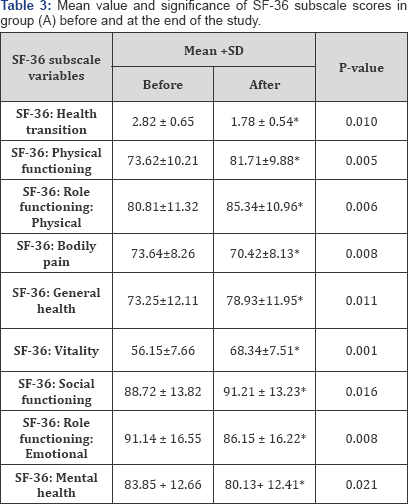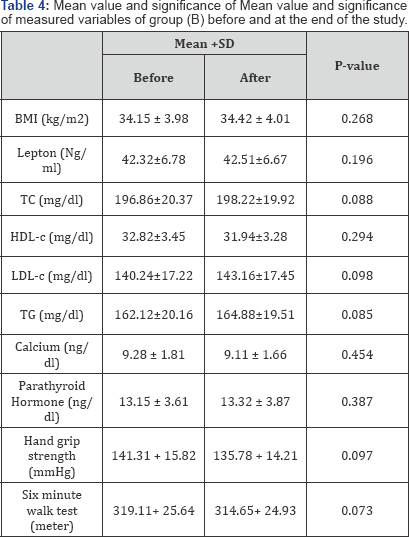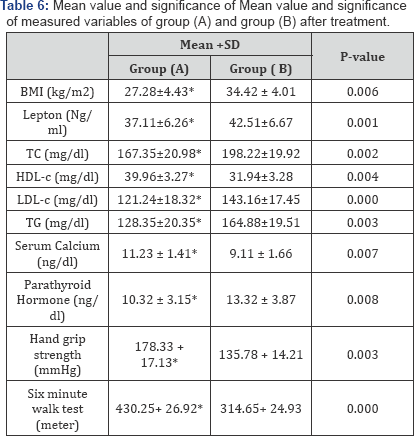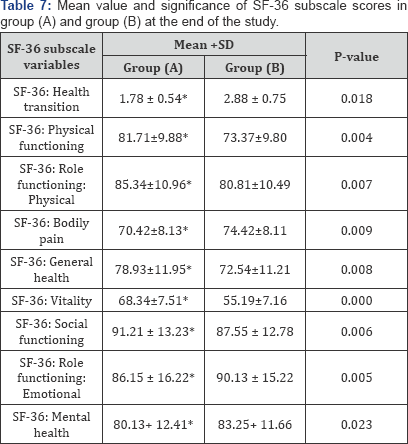Influence of Weight Loss on Quality Of Life, Biochemical & Clinical Parameters among Obese Postmenopausal Women
Shehab M Abd El Kader1* and Osama H Al Jiffri2
1Department of Physical therapy, King Abdulaziz University, Saudi Arabia
2Department of Medical Laboratory Technology, King Abdulaziz University, Saudi Arabia
Submission: February 02, 2017; Published: February 22, 2017
*Corresponding author: Shehab M Abd El Kader, Faculty of Applied Medical Sciences, Department of Physical Therapy, King Abdulaziz University, P.O. Box 80324, Jeddah, 21589, Saudi Arabia,Email: profshehab@live.com
How to cite this article: Shehab M A El K, Osama H Al J. Influence of Weight Loss on Quality Of Life, Biochemical & Clinical Parameters among Obese Postmenopausal Women. OAJ Gerontol & Geriatric Med. 2017; 1(1): 555553.
Abstract
Background: Although obesity is common among postmenopausal, to date no study has evaluated the influence of weight loss on quality of life (QOL), biochemical & clinical parameters among obese postmenopausal women.
Objective: This study designed to detect the effects of weight reduction on biochemical & clinical parameters and QOL among obese postmenopausal women.
Material and Methods: Two-hundred Saudi postmenopausal obese women enrolled in this study, their age will be ranged from 50- 58 years and their body mass index (BMI) ranged from 30-35 kg/m2. All participants were divided into two equal groups: group (A) received weight reduction program (aerobic exercise and diet regimen) for 3 months and group (B) received no exercise training or diet regimen.
Results: The mean values of Health-related quality of life (SF-36 HRQL) subscale scores, serum calcium, high density lipoprotein cholesterol (HDL-cholesterol), hand grip strength and Six Minute Walk Test (6MWT) were significantly improved in group (A). While the mean values of serum parathyroid hormone (PTH), plasma lepton, triglycerides, total cholesterol, low density lipoprotein cholesterol (LDL- cholesterol), total cholesterol (TC), triglycerides and BMI were reduced significantly in group (A). In addition, differences between both groups were significant at the end of the study.
Conclusion: The current study provides evidence that weight reduction program improves QOL, biochemical and clinical parameters among obese postmenopausal women.
Keywords : Obesity; Menopause; Quality of Life; Weight Reduction
Abbreviations: QOL: Quality of Life; BMI: Body Mass Index; HRQL: Health Related Quality of Life; HDL-Cholesterol: High Density Lipoprotein Cholesterol; 6MWT: Six Minute Walk Test; PTH: Para Thyroid Hormone; LDL-Cholesterol: Low Density Lipoprotein Cholesterol; TC: Total Cholesterol.
Introduction
Obesity among postmenopausal women is usually associated with poor health-related quality of life (HRQOL) [1]. In USA, about 70% of adults are either obese or overweight [2,3] and globally, 1.5 billion adult are either obese or overweight [4] in addition to about 2.8 million subjects die of obesity related co-morbidities as cardiovascular disorders and diabetes [5]. Moreover, researches proved that all measures of quality of life (QOL) are adversely affected by obesity in addition to depression, low self-esteem poor general health [6,7]. Blood lipid profile and glucose homeostasis are abnormal that induce cardiovascular disorders 2-fold among obese subjects more than normal body weight subjects [8]. However, life style modification can modulate all cardiovascular disorders risk factors associated with obesity [9-13]. Weight reducing programs that combine both exercise training and diet regimen are superior to either exercise or diet regimen [14-17].
Some previous studies proved that weight reduction improves blood lipid profile [18-20] and HRQOL [21-23]. However, others believe that HRQOL could be improved without anthropometric changes [24]. Therefore, the aim of this study was to examine the effects of weight reduction program on biochemical & clinical parameters and quality of life for obese postmenopausal women in kingdom of Saudi Arabia.
Patients and methods
Subjects
Two-hundred postmenopausal obese women enrolled in this study, the mean of their age was 54.67±5.28 year, the mean of their BMI was 33.94±4.27 kg/m2 and menopause since at least 5 years. Exclusion criteria included smoking, endocrine disorders, musculoskeletal disorders, renal disorders, liver disorders, cardiac disorders, respiratory disorders and diabetes. All Subjects were randomly enrolled into two equal groups: group (A) received weight reduction program (aerobic exercise and diet regimen) for 3 months and group (B) received no exercise training or diet regimen.
Measurements
- Health-related quality of life (SF-36 HRQL): Quality of life was assessed using SF-36 HRQL that includes eight subscales: Bodily Pain, Vitality, Physical Functioning, Social Functioning, General Health, Emotional Role Functioning, Physical Role Functioning and Mental Health [21].
- Hand Grip Strength: Jamar hand dynamometer was used to measure the hand grip strength through applying 3 successive trials using Sammons Preston Roland, Cedarburg, WI, USA, the mean value of the three trials of measurements was recorded and used in the statistical analysis.
- Six Minute Walk Test (6MWT): All participants were asked to conduct 6MWT through fast walking around 2 cones that were placed 40 meters a part, each participants were asked to have 2 trials in two different days and the record walking distance of the second days was used in the statistical analysis [25-27].
- Biochemical analyses: Overnight fasting venous blood sample was taken to measure serum calcium, high density lipoprotein cholesterol (HDL-cholesterol), plasma lepton, triglycerides, total cholesterol, low density lipoprotein cholesterol (LDL-cholesterol), total cholesterol (TC) and triglycerides through chromatography method using Beranger Mannheim kit. However, measurement of serum parathyroid hormone (PTH) was performed using the principle of Electro chemiluminescence's immunoassay (Modular Analytics E170, Roche, Germany).
Procedures
Participants were randomly included into two equal groups as following:
i. Group (A): Received treadmill aerobic exercise training with a five minutes warming-up phase done on the treadmill (Track master 400E, gas fitness system, England) with low load, actual training time was thirty minutes with an intensity of 7080% of HRmax and finally five minutes of cooling down that was done in the form of running or walking; 3 sessions / week for 3 months [28]. In addition, all participants were instructed to follow diet regimen that provide 1200 kcal/day as recommended by WHO under close supervision of dietitian [18].
ii. Group (B): Was considered as a control group and received no training intervention for six months.
Statistical analysis
SPSS (Chicago, IL, USA) version 17 was used in statistical analysis, where the investigated parameters of both groups obtained before and at the end of the study were compared. However, comparison between the investigated parameters of both groups done using independent "t". All data were expressed as the mean ± SD (P<0.05).
Results
The baseline characteristics of all participants are shown in (Table 1). None of the baseline characteristics differed significantly between the two groups. The mean values of SF- 36 subscale scores, serum calcium, HDL cholesterol and 6MWT were significantly increased in group (A). While the mean values of serum PTH , plasma lepton, triglycerides, total cholesterol, LDL cholesterol, TC, TG and BMI were significantly decreased in group (A) (Tables 2 & 3), while results of group (B) showed no significant changes (Tables 4 & 5). However, the differences between mean values of the investigated parameters in both groups were significant at the end of the study (Tables 6 & 7).

BMI: Body Mass Index; ALT: Almandine aminotransferases; AST: Aspartate aminotransferases; SBP: Systolic Blood Pressure; DBP:Diastolic Blood Pressure.

TC: Total Cholesterol; HDL-c: High Density Lipoprotein Cholesterol; LDL-c: Low Density Lipoprotein Cholesterol; TG: Triglyceride; indicates a significant difference between the two groups; P < 0.05.

(*) indicates a significant difference between the two groups; P < 0.05.

TC: Total cholesterol; HDL-c: High density lipoprotein cholesterol; LDL-c: Low density lipoprotein cholesterol; TG: Triglyceride; (*)indicates a significant difference between the two groups; P < 0.05


TC: Total Cholesterol; HDL-c: High Density Lipoprotein Cholesterol; LDL-c: Low Density Lipoprotein Cholesterol; TG: Triglyceride; (*)indicates a significant difference between the two groups; P < 0.05.

(*) indicates a significant difference between the two groups; P < 0.05.
Discussion
Quality of life along with biochemical parameters were found to be adversely affected by obesity [29-38]. Therefore, this study was designed to detect the effects of weight reduction on biochemical & clinical parameters and QOL among obese postmenopausal women. The principal finding in this study indicated that weight reducing program improved subscales of QOL among obese postmenopausal women. Many previous studies reported that weight loss improves HRQOL among obese subjects [33-38], type 2 diabetes mellitus [39] and osteoarthritis [40]. While, Ross et al. [23] reported that a six months weight reducing program among 298 obese women that resulted in 9.4% weight loss resulted improvement in vitality scores and physical functioning. However, Blissmer et al. [33] proved that improvements in subscales of SF-36 was obtained in 144 overweight/obese adults after six months of weight reducing program that resulted in 5.6 kg of weight loss. Moreover, Riesco and colleagues [41] stated that modest loss of body weight following 16-week of aerobic exercise training improved QOL, physical and mental well-being in obese women.
In our study blood lipids profile and lepton were significantly modulated as a result of weight reduction in obese postmenopausal women. Similarly, Shephard and Balady [42] noticed that regular practice of physical activities had a modulating effect on blood lipids profile by favoring the reduction of cholesterol, LDL-cholesterol and triglycerides in addition to increased HDL-cholesterol level. Also, García et al[43] stated that an ambulatory physical exercise program for 12 weeks improves QOL and biochemical parameters through weight loss in obese postmenopausal women. However, Tran and Weltman [44] found that modulation of lipid profile correlated with weight loss. In addition, Sartorio and colleagues [45] mentioned that reduction of body weight reduced serum level of lepton. Moreover Volek and colleagues [46] reported that 2 months weight reducing program significantly modulated serum level of lepton.
Furthermore, on analyzing the parameters studied in the 6MWT and hand grip strength, our results showed a significant improvement in patients' performance as a result of weight reduction as there is evidence that excess weight may adversely interfere with physical activities [47]. Our findings were consistent with Enright and Sherrill [48] who founded that the distance forecast for the 6MWT was higher in subjects who lost weight. However, a study carried out by Maniscalco et al. [49] showed an improvement of the 6MWT parameters in the late postoperative period of bariatric surgery. Moreover, Lemoine and colleagues [50] proved that postmenopausal obese women had a significant improvement in measures of QOL and walking distance following three weeks of weight reducing program.
Conclusion
The current study provides evidence that weight reduction program improves QOL, biochemical and clinical parameters among obese postmenopausal women.
Acknowledgment
This project was funded by the Deanship of Scientific Research (DSR) at King Abdulaziz University, Jeddah, under grant no. (G-29-142-36). The authors, therefore, acknowledge with thanks DSR for technical and financial support.
References
- Jones G, Sutton A (2008) Quality of life in obese postmenopausal women. Menopause Int 14(1): 26-32.
- Flegal K, Carroll M, Ogden C, Curtin L (2010) Prevalence and trends in obesity among US adults, 1999-2008. JAMA 303(3): 235-241.
- Fuller N, Lau N, Denyer G, Simpson A, Gerofi J, et al. (2012) A 12- week, randomised, controlled trial to examine the acceptability of the Korean diet and its effectiveness on weight and metabolic parameters in an Australian overweight and obese population. Obesity Research & Clinical Practice 6(1): e1-e90.
- World Health Organisation (2011) Obesity and overweight. Geneva, Switzerland.
- World Health Organisation (2011) Global strategy on diet, physical activity and health. World Health Organization, Geneva, Switzerland.
- Kruger J, Bowles HR, Jones DA, Ainsworth BE, Kohl HW (2007) Health related quality of life, BMI and physical activity among US adults (N = 18 years): National physical activity and weight loss survey, 2002. Int J Obes 31(2): 321-327.
- McInnes R, Gray C (2013) Obese Women and Quality of Life. Obesity 15: 585-595.
- Mottillo S, Filion KB, Genest J, Joseph L, Pilote L, Poirier P, et al. (2010) The metabolic syndrome and cardiovascular risk a systematic review and meta-analysis. J Am Coll Cardiol 56: 1113-1132.
- Saaristo T, Moilanen L, Korpi-Hyovalti E, Vanhala M, Saltevo J, Niskanen L, et al. (2010) Lifestyle intervention for prevention of type 2 diabetes in primary health care: one-year follow-up of the Finnish National Diabetes Prevention Program (FIN-D2D). Diabetes Care 33(10): 21462151.
- Voeghtly LM, Neatrour DM, Decewicz DJ, Burke A, Haberkorn MJ, Lechak F, et al. (2013) Cardiometabolic risk reduction in an intensive cardiovascular health program. Nutr Metab Cardiovasc Dis 23(7): 662-669.
- Stevenson J (2006) Metabolic profile and cardiovascular system through menopause and ageing: impact on quality of life. Proceedings of 6th IMS Workshop: Menopause and Ageing, Quality of Life and Sexuality. Pisa Italy 14: 1-7.
- Milewicz A, Demissie M (2002) Metabolic and endocrine changes in climacteric women. International Congress Series 1229: 3-7.
- Netjasov A, Vujović S, Ivovič M, Tanćić-Gajić M, Marina L, et al. (2013) Relationships between Obesity, Lipids and Fasting Glucose in the Menopause. Srp Arh Celok Lek 141(1-2): 41-47.
- Arterburn D, Crane P, Sullivan S (2004) The coming epidemic of obesity in elderly Americans. J Am Geriatr Soc 52(11): 1907-1912.
- Wooten JS, Phillips MD, Mitchell JB (2011) Resistance exercise and lipoproteins in postmenopausal women. Int J Sports Med 32(1): 7-13.
- Orozco LJ, Buchleitner AM, Gimenez-Perez G, Roque IFM, Richter B,et al. (2008) Exercise or exercise and diet for preventing type 2 diabetes mellitus. Cochrane Database Syst Rev 3: CD003054.
- Franz MJ, VanWormer JJ, Crain AL, Boucher JL, Histon T, et al. (2007) Weight-loss outcomes. A systematic review and meta-analysis of weight-loss clinical trials with a minimum 1-year follow-up. J Am Diet Assoc 107(10): 1755-1767.
- Skouroliakou M, Giannopoulou I, Kostara C, Koutri K, Stathopoulou M,et al. (2010) Effects of a nutritional intervention in obese postmenopausal women on atypical antipsychotics. Maturitas 67: 166-170.
- Deibert P, Konig D, Vitolins MZ (2007) Effect of a weight loss intervention on anthropometric measures and metabolic risk factors in pre- versus postmenopausal women. J Nutr 6: 24-31.
- Hagey AR, Warren MP (2008) Role of exercise and nutrition in menopause. Clin Obstet Gynecol 51(3): 627-641.
- Oldenburg S , Boll D, Nicolaije K, Vos M, Pijnenborg J, et al. (2013)The relationship of body mass index with quality of life among endometrial cancer survivors: A study from the population-based PROFILES registry. Gynecol Oncol 129(1): 216-221.
- Palmeira AL, Markland DA, Silva MN, Branco TL, Martins SC, et al. (2009) Reciprocal effects among changes in weight, body image, and other psychological factors during behavioral obesity treatment: a mediation analysis. Int J Behav Nutr Phys Act 6: 1-9.
- Ross KM, Milsom VA, Rickel KA, Debraganza N, Gibbons LM, et al. (2009) The contributions of weight loss and increased physical fitness to improvements in health-related quality of life. Eat Behav 10(2): 8488.
- Williamson DA, Rejeski J, Lang W, Van Dorsten B, Fabricatore AN, et al. (2009) Impact of a weight management program on health-related quality of life in overweight adults with type 2 diabetes. Arch Intern Med 169(2): 163-171.
- Turner S, Eastwood P, Cecins M, Hillman D, Jenkins C (2004) Physiologic responses to incremental and self-paced exercise in COPD: A comparison of three tests. Chest 126(3): 766-773.
- Larsson U, Karlsson J, Sullivan M (2002) Impact of overweight and obesity on health-related quality of life-Swedish populations study. International Journal of Obesity 26(3): 417-424.
- Blain H, Jaussent A, Béziat S (2012) Low serum IL-6 is associated with high 6-minute walking performance in asymptomatic women aged 20 to 70 years. Exp Gerontol 47(2): 143-148.
- Sciacqua A, Candigliota M, Ceravolo R, Scozzafava A, Sinopoli F, et al. (2003) Weight loss in combination with physical activity improves endothelial dysfunction in human obesity. Diabetes Care 26(6): 16731678.
- Murakami T, Horigome H, Tanaka K, Nakata Y, Ohkawara K, et al. (2007) Impact of weight reduction on production of platelet-derived microparticles and fibrinolytic parameters in obesity .Thrombosis Research 119: 45-53.
- Doll HA, Peterson SE, Stewart Brown SL (2000) Obesity and physical and emotional wellbeing: associations between body mass index, chronic illness, and the physical and mental components of the SF-36 questionnaire. Obes Res 8(2): 160-170.
- Richards MM, Adams TD, Hunt SC (1999) Functional status and emotional wellbeing, dietary intake, physical activity of severely obese subjects. J Am Diet Assoc 100(1): 67-75.
- Coakley EH, Kawachi I, Manson JE (1998) Lower levels of physical functioning are associated with higher body weight among middle- aged and older women. Int J Obes Relat Metab Disord 22(10): 958965.
- Blissmer B, Riebe D, Dye G, Ruggiero L, Greene G, et al. (2006) Health- related quality of life following a clinical weight loss intervention among overweight and obese adults: intervention and 24 month follow-up effects. Health Qual Life Outcomes 4: 36-43.
- Kaukua J, Pekkarinen T, Sane T, Mustajoki P (2003) Health-related quality of life in obese outpatients losing weight with very-low-energy diet and behavir modification-^ 2-y follow-up study. Int J Obes Relat Metab Disord 27(10): 1233-1241.
- Bowen DJ, Fesinmeyer MD, Yasui Y, Tworoger S, Ulrich CM, et al. (2006) Randomized trial of exercise in sedentary middle aged women: effects on quality of life. Int J Behav Nutr Phys Act 3: 26-34.
- Norris SL, Zhang X, Avenell A, Gregg E, Bowman B, et al. (2004) Longterm effectiveness of lifestyle and behavioral weight loss interventions in adults with type 2 diabetes: a meta-analysis. Am J Med 117(10): 762-774.
- Wing RR (1999) Physical activity in the treatment of the adulthood overweight and obesity: Current evidence and research issues. Med Sci Sports Exerc 31(11 Suppl): S547-S552.
- Imayama I, Alfano C, Kong A, Foster Schubert K, Bain C, et al. (2011) Dietary weight loss and exercise interventions effects on quality of life in overweight/obese postmenopausal women: a randomized controlled trial. Int J Behav Nutr Phys Act 8: 110-118.
- Kaplan RM, Hartwell SL, Wilson DK, Wallace JP (1987) Effects of diet and exercise interventions on control and quality of life in non-insulindependent diabetes mellitus. J Gen Intern Med 2(4): 220-228.
- Rejeski WJ, Focht BC, Messier SP, Morgan T, Pahor M, et al. (2002) Obese, older adults with knee osteoarthritis: weight loss, exercise, and quality of life. Health Psychol 21(5): 419-426.
- Riesco E, Tessier S, Pérusse F, Turgeon S, Tremblay A, et al. (2010) Impact of walking on eating behaviors and quality of life of premenopausal and early postmenopausal obese women. Menopause 17(3): 529-538.
- Shephard RJ, Balady GJ (1999) Exercise as cardiovascular therapy Circulation 99(7): 963-972.
- García G, Ferrer G, Baixauli R, Albalat G, Elvira M, et al. (2009) An ambulatory physical exercise program improves in the short term weight and quality of life of obese post-menopausal women. Med Clin (Bare) 133(14): 533-538.
- Tran ZV, Weltman A (1985) Differential effects of exercise on serum lipid and lipoprotein levels seen with changes in body weight. A metaanalysis. JAMA 254(7): 919-924.
- Sartorio A, Agosti F, Resnik M, Lafortuna CL (2003) Effects of a 3-week integrated body weight reduction program on leptin levels and body composition in severe obese subjects. J Endocrinol Invest 26(3): 250256.
- Volek JS, Gomez AL, Love DM, Weyers AM, Hesslink R, et al. (2002) Effects of an 8-week weight-loss program on cardiovascular disease risk factors and regional body composition. Eur J Clin Nutr 56(7): 585592.
- Hulens M, Vansant G, Lysens R, Claessens AL, Muls E (2001) Exercise capacity in lean versus obese women. Scand J Med Sci Sports 11(5): 305-309.
- Enright PL, Sherrill DL (1998) Reference equations for the six-minute walk in healthy adults. Am J Respir Crit Care Med 158: 1384-1387.
- Maniscalco M, Zedda A, Giardiello C, Faraone S, Cerbone MR, et al. (2006) Effect of bariatric surgery on the six-minute walk test in severe uncomplicated obesity. Obes Surg 16(17): 836-841.
- Lemoine S, Rossell N, Drapeau V, Poulain M, Garnier S, et al. (2007) Effect of weight reduction on quality of life and eating behaviors in obese women. Menopause 14: 432-440.






























